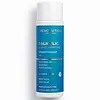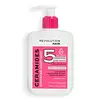What's inside
What's inside
 Key Ingredients
Key Ingredients

 Benefits
Benefits

 Concerns
Concerns

 Ingredients Side-by-side
Ingredients Side-by-side

Water
Skin ConditioningGlycerin
HumectantButylene Glycol
HumectantCetyl Alcohol
EmollientStearyl Alcohol
EmollientCocamide Mea
EmulsifyingBetaine
HumectantSalicylic Acid
MaskingCetrimonium Chloride
AntimicrobialBenzyl Alcohol
PerfumingParfum
MaskingPiroctone Olamine
PreservativeBehentrimonium Chloride
PreservativeQuaternium-91
Panthenol
Skin ConditioningCetearyl Alcohol
EmollientHydroxyethylcellulose
Emulsion StabilisingCitric Acid
BufferingCetrimonium Methosulfate
AntimicrobialDisodium EDTA
PEG-40 Hydrogenated Castor Oil
EmulsifyingDehydroacetic Acid
PreservativeIsopropyl Alcohol
SolventMelaleuca Alternifolia Leaf Oil
AntioxidantLinalool
PerfumingTribehenin
EmollientHelianthus Annuus Seed Extract
Skin ConditioningPantolactone
HumectantSodium Benzoate
MaskingPotassium Sorbate
PreservativeWater, Glycerin, Butylene Glycol, Cetyl Alcohol, Stearyl Alcohol, Cocamide Mea, Betaine, Salicylic Acid, Cetrimonium Chloride, Benzyl Alcohol, Parfum, Piroctone Olamine, Behentrimonium Chloride, Quaternium-91, Panthenol, Cetearyl Alcohol, Hydroxyethylcellulose, Citric Acid, Cetrimonium Methosulfate, Disodium EDTA, PEG-40 Hydrogenated Castor Oil, Dehydroacetic Acid, Isopropyl Alcohol, Melaleuca Alternifolia Leaf Oil, Linalool, Tribehenin, Helianthus Annuus Seed Extract, Pantolactone, Sodium Benzoate, Potassium Sorbate
Water
Skin ConditioningCetearyl Alcohol
EmollientGlyceryl Stearate
EmollientGlycerin
HumectantCetyl Alcohol
EmollientHydrogenated Ethylhexyl Olivate
EmollientPhenoxyethanol
PreservativeCetrimonium Chloride
AntimicrobialBehentrimonium Chloride
PreservativeHydroxyethylcellulose
Emulsion StabilisingBehentrimonium Methosulfate
Hydrogenated Olive Oil Unsaponifiables
EmollientIsopropyl Alcohol
SolventCitric Acid
BufferingStearyl Alcohol
EmollientEthylhexylglycerin
Skin ConditioningDisodium EDTA
Polyquaternium-4
Sodium Hyaluronate
HumectantCeramide NP
Skin Conditioning2,3-Butanediol
HumectantHydrogenated Lecithin
EmulsifyingCeramide AP
Skin ConditioningCeramide As
Skin ConditioningCholesterol
EmollientCeramide Ns
Skin ConditioningCeramide EOP
Skin ConditioningWater, Cetearyl Alcohol, Glyceryl Stearate, Glycerin, Cetyl Alcohol, Hydrogenated Ethylhexyl Olivate, Phenoxyethanol, Cetrimonium Chloride, Behentrimonium Chloride, Hydroxyethylcellulose, Behentrimonium Methosulfate, Hydrogenated Olive Oil Unsaponifiables, Isopropyl Alcohol, Citric Acid, Stearyl Alcohol, Ethylhexylglycerin, Disodium EDTA, Polyquaternium-4, Sodium Hyaluronate, Ceramide NP, 2,3-Butanediol, Hydrogenated Lecithin, Ceramide AP, Ceramide As, Cholesterol, Ceramide Ns, Ceramide EOP
Ingredients Explained
These ingredients are found in both products.
Ingredients higher up in an ingredient list are typically present in a larger amount.
This ingredient is a preservative and often used for it's anti-static properties. You'll most likely see this ingredient in hair conditioners.
It does not cause irritation or sensitization in leave-on products at 1-5%.
Cetearyl alcohol is a mixture of two fatty alcohols: cetyl alcohol and stearyl alcohol. It is mainly used as an emulsifier. Emulsifiers help prevent the separation of oils and products. Due to its composition, it can also be used to thicken a product or help create foam.
Cetearyl alcohol is an emollient. Emollients help soothe and hydrate the skin by trapping moisture.
Studies show Cetearyl alcohol is non-toxic and non-irritating. The FDA allows products labeled "alcohol-free" to have fatty alcohols.
This ingredient is usually derived from plant oils such as palm, vegetable, or coconut oils. There is debate on whether this ingredient will cause acne.
Due to the fatty acid base, this ingredient may not be Malassezia folliculitis safe.
Learn more about Cetearyl AlcoholThis ingredient is a preservative, antimicrobial, and emulsifier. It is often used in cosmetics for its ability to cleanse, condition, and reduce static.
Cetrimonium chloride is a quaternary ammonium salt, meaning it has a water-soluble structure.
Cetyl Alcohol is a fatty alcohol. Fatty Alcohols are most often used as an emollient or to thicken a product.
Its main roles are:
Though it has "alcohol" in the name, it is not related to denatured alcohol or ethyl alcohol.
The FDA allows products labeled "alcohol-free" to have fatty alcohols.
Learn more about Cetyl AlcoholCitric Acid is an alpha hydroxy acid (AHA) naturally found in citrus fruits like oranges, lemons, and limes.
Like other AHAs, citric acid can exfoliate skin by breaking down the bonds that hold dead skin cells together. This helps reveal smoother and brighter skin underneath.
However, this exfoliating effect only happens at high concentrations (20%) which can be hard to find in cosmetic products.
Due to this, citric acid is usually included in small amounts as a pH adjuster. This helps keep products slightly more acidic and compatible with skin's natural pH.
In skincare formulas, citric acid can:
While it can provide some skin benefits, research shows lactic acid and glycolic acid are generally more effective and less irritating exfoliants.
Most citric acid used in skincare today is made by fermenting sugars (usually from molasses). This synthetic version is identical to the natural citrus form but easier to stabilize and use in formulations.
Read more about some other popular AHA's here:
Learn more about Citric AcidDisodium EDTA plays a role in making products more stable by aiding other preservatives.
It is a chelating agent, meaning it neutralizes metal ions that may be found in a product.
Disodium EDTA is a salt of edetic acid and is found to be safe in cosmetic ingredients.
Learn more about Disodium EDTAGlycerin is already naturally found in your skin. It helps moisturize and protect your skin.
A study from 2016 found glycerin to be more effective as a humectant than AHAs and hyaluronic acid.
As a humectant, it helps the skin stay hydrated by pulling moisture to your skin. The low molecular weight of glycerin allows it to pull moisture into the deeper layers of your skin.
Hydrated skin improves your skin barrier; Your skin barrier helps protect against irritants and bacteria.
Glycerin has also been found to have antimicrobial and antiviral properties. Due to these properties, glycerin is often used in wound and burn treatments.
In cosmetics, glycerin is usually derived from plants such as soybean or palm. However, it can also be sourced from animals, such as tallow or animal fat.
This ingredient is organic, colorless, odorless, and non-toxic.
Glycerin is the name for this ingredient in American English. British English uses Glycerol/Glycerine.
Learn more about GlycerinHydroxyethylcellulose is used to improve the texture of products. It is created from a chemical reaction involving ethylene oxide and alkali-cellulose. Cellulose is a sugar found in plant cell walls and help give plants structure.
This ingredient helps stabilize products by preventing ingredients from separating. It can also help thicken the texture of a product.
This ingredient can also be found in pill medicines to help our bodies digest other ingredients.
Learn more about HydroxyethylcelluloseIsopropyl Alcohol is more commonly known as rubbing alcohol. It is most commonly used as a solvent, meaning it helps other ingredients dissolve.
This ingredient is an astringent alcohol. Astringent alcohols may also irritate skin as they high amounts may strip away your skin's natural oils.
Other types of astringent alcohols include:
According to the National Rosacea Society based in the US, you should be mindful of products with these alcohols in the top half of ingredients.
Any type of sanitizing product will have high amounts of alcohol to help kill bacteria and viruses.
Learn more about Isopropyl AlcoholStearyl Alcohol is a type of fatty alcohol from stearic acid. It is a white, waxy compound used to emulsify ingredients.
Fatty Alcohols are most often used as an emollient or to thicken a product. Emollients help soothe and hydrate the skin by trapping moisture.
They are usually derived from natural fats and oils and therefore do not have the same drying or irritating effect as solvent alcohols. FDA allows products labeled "alcohol-free" to have fatty alcohols.
Learn more about Stearyl AlcoholWater. It's the most common cosmetic ingredient of all. You'll usually see it at the top of ingredient lists, meaning that it makes up the largest part of the product.
So why is it so popular? Water most often acts as a solvent - this means that it helps dissolve other ingredients into the formulation.
You'll also recognize water as that liquid we all need to stay alive. If you see this, drink a glass of water. Stay hydrated!
Learn more about Water